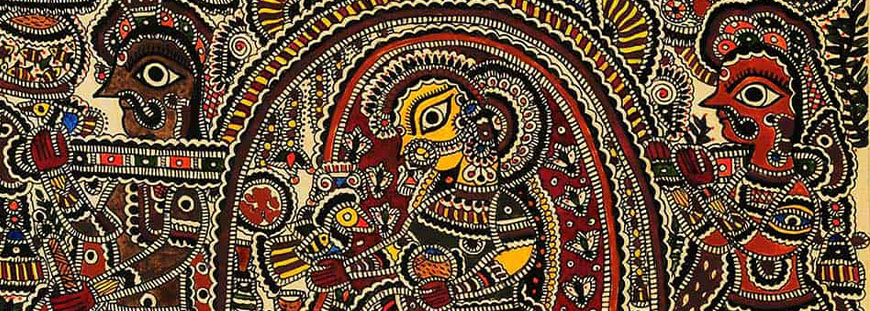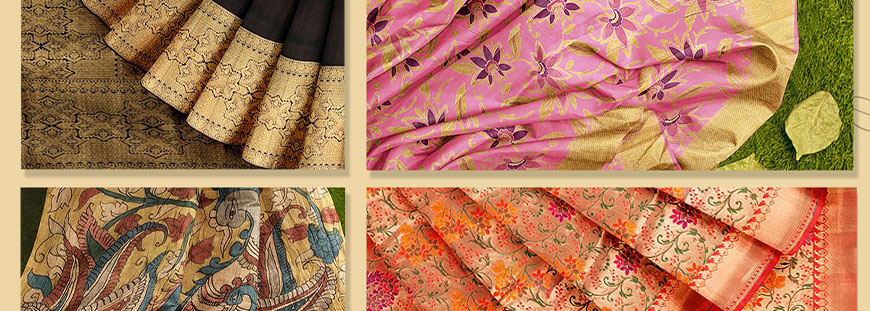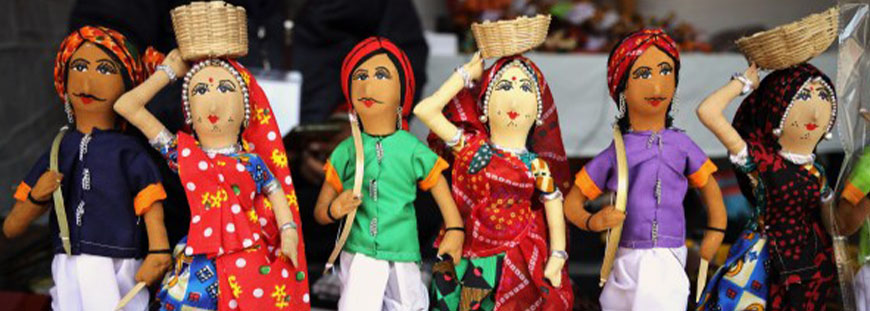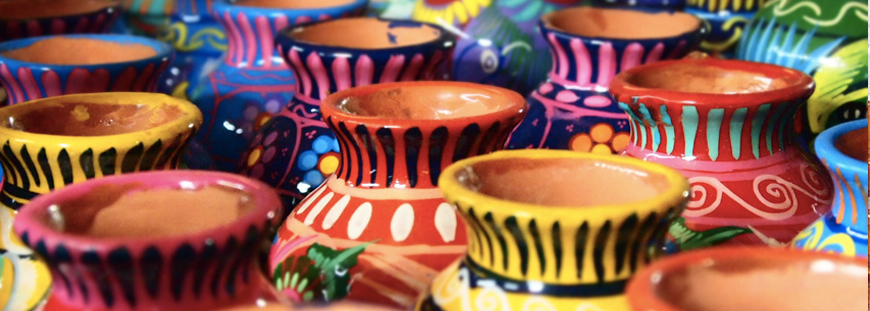Author: sylvester_bindura
10 Distinct Types of Paintings in Indian Artistry
India has a prosperous cultural variety which is generously expressed in the vivid, distinct, and fascinating folk art and craft. Numerous painting methods are prevalent across various nations, each depicting beliefs, traditions, customs, and philosophies passed on from generation after generation. Traditionally, most of the Indian painting styles prevailed as wall paintings or murals. In due course of the period, urbanization gave rise to these aspects of painting on paper, canvas, and fabric, etc. Indian creation techniques are not just a reflection of the indigenous lifestyle but a true representation of artistic expression through modest yet distinct compositions.
Here are some of the prominent Indian culture painting styles listed below:-
1.Madhubani Paintings
Untitled by Baua Devi
One of the vastly prominent styles of folk paintings in India is Madhubani. Originated in the Mithila region of Bihar as an aspect of Wall art. This stunning art style was anonymous to the external world until discovered by the British colonial William G. Archer in 1934 while examining the damage after the tremendous Bihar earthquake. Archer was stunned by the wonderful illustrations on the exposed interior walls of the houses. The beauty of Madhubani lies in its simple and suggestive illustration of culture and traditions. Bharni, Katchni, Tantrik, Godna, and Kohbar are the five examples of distinct techniques of Madhubani painting.
2. Warli Paintings
Warli Art by Unknown Artist
The 2500-year- old tradition of Warli Paintings of Thane and Nasik regions in the state of Maharashtra is quite popular even now and it is closely related to the nature and social rituals of the clan. Warli Paintings showcase formal activities of the regional people of the community like farming, dancing, praying, hunting, etc. Traditionally, women used twigs to bring out likely designs with rice paste on mud walls on the tribal huts to mark celebrations of harvests or marriages. Simple geometric structures in white against a red or yellow surface are used to illustrate mundane life scenes. Warli art with its linear and monochromatic hues resembles the cave paintings of the prehistoric era.
3. Kalighat painting or Bengal Pat
Kalighat painting by Unknown Artist
The Kalighat painting style was evolved during the mid 19th century in a community near a Kali temple in Calcutta. The sketches on paper were executed by a group known as”Patuas” hence the term Kalighat Pata. They portrayed scenes of everyday life and mythological deities in a simple yet absorbing manner and formulated into the popular Kalighat style of painting. Kalighat painters mainly use loamy Indian colors like indigo, ochre, red, grey, white and blue. The swift, seamless, free-flowing outline is a distinct aspect of the Kalighat style of printings. This painting style has inspired many artists, like the famous Jamini Roy.
4. Phad
Story of Pabuji by Kalyan Joshi
Phad is the narrative scroll painting ritual in Rajasthan, dating about a thousand years. Statements of local deities and fighters are sketched on horizontal cloth scrolls in tones of red, orange, and yellow. The Phad scroll expresses depictions of the battleground, expedition stories, and legendary states. The style of painting in Phad is that evacuates spellbound expression at how the folk artists adapt multiple tales in a single composition by preserving the aesthetic of artistic expression.
5. Kalamkari
Kalamkari Art by Unknown Artist
Kalamkari is a 3000-year-old organic art and craft of hand and block printing. It was traditionally utilized for preparing narrative scrolls and panels. This exquisite folk art has a strong relation with Persian motifs. Kalamkari emerges its term from ‘Kalam’ or pen and is a legacy that has been handed down from generation to generation in Andhra Pradesh. Kalamkari art primarily involves earthy colors like indigo, green, rust, black, and mustard.
6. Miniature Painting
Miniature by Unknown Artist
The Miniature painting method occurred in India with the Mughals in the 16th century. It was observed as a significant milestone in the history of Indian art. It developed into a distinct style with a combination of Indian, Islamic, and Persian components. The painting is executed using natural stone color on a paper-based “Waali”. Mineral colors, conch shells, expensive stones, gold, and silver are used in the Miniatures. Fine brushwork intricacy, detailing, and stylization are the distinct characteristics of miniature painting. The Miniature painting style has developed in districts like Kangra Rajasthan, Malwa, Pahadi, Mughal, Deccan, etc.
7. Gond Painting
Untitled by Venkat Raman Singh
These are vibrant paintings organized with a series of intricately arranged dots and dashes. It was improved by the Gondi tribe of Central India. The tribals recreate mythical stories and verbal histories to traditional songs, natural surroundings, significant events, and rituals with great sophistication, creative detailing, and depicted in bright colors. These colors emerged from varied natural resources like plant sap, mud, flowers, charcoal, colored soil, leaves, etc. Gond artists now move beyond being a tribal art style with nameless artists to having internationally renowned artists like Janharh Singh Shyam, Venkat Shyam, Bhajji Shyam, Durga Bai Vyam to name a few.
8. Kerala Murals
Kerala Murals Painting by Unknown Artist
Kerala Mural paintings are one of the world’s most famous vibrant frescoes which have deep spiritual origins portraying the themes of Hindu mythology, epics, the traditional frolic of Krishna, and the mystic forms of Shiva and Shakti. They recount some legendary fighters of the bygone era. This style dates to the 7th and 8th century AD and is depicted by vibrant imagery, bold strokes, and painted in bright colors like ochre- red, yellow- ochre, bluish-green, white, and pure color are predominantly used in this painting.
9. Patachitra
Odisha patachitra by Unknown Artist
The cloth scroll painting of folklore from Odisha that is Patachitra, is devoted to mythical and spiritual themes. Strong contours with vibrant colors like yellow, white,red, and black with adorning barriers are mainly the aspects of the Patachitra painting style, which is cherished by art enthusiasts across the world.
10. Pichwai
Pichwai painting by Unknown Artist
The art of Pichwai originated as wall hangings placed behind the central deity in Krishna temples in the district of Nathdwara. They narrate stories related to Lord Krishna. Pichwais are vivid and detailed paintings with secret symbolism in the artistic design or pattern. This region’s devotional art tradition has passed from one generation to another. It is a wonderful representation of spirituality in art.
Famous Traditional And Regional Sarees of India
Saree is archconservative as well as traditional attire of females with different styles of draping, varying from five to nine yards in length. There are an additional 80 ways to wear a saree, among them Nivi style is the most popular.
As distant additional 35 types of sarees are available in India they are Banarasi Silk Sarees, Khun Sarees, Kasheeda Saree, Chanderi Sarees, Kasut Sarees, Kanjeevaram Sarees, Assam Sarees, Batik Print Sarees, Tant Saree, Tussar Silk Sarees, Assam Muga Silk Sarees, Dhakai Jamdani Saree, Pochampally Sarees, Cotton Sarees, Mysore Silk Sarees, Bhagalpuri Silk Sarees, Mundum Neriyathum, Maheshwari Sarees, and Pattu sarees.
Types of Traditional wedding Sarees for Indian Women include Kanjeevaram wedding saree, Banarasi wedding saree, Sambalpuri wedding saree, Assam Silk Goat saree, Resham saree, Zardosi saree, Paithani sarees, Bomkai saree, Bandhani saree, and Neriyathum saree.
Some sarees are explained briefly, they are as follows:-
1. Banarasi Saree
The most popular Banarasi Saree originated in Varanasi is known for its gold and silver zari work. These sarees are made of sensitively woven silk and are among the finest sarees in India during many wedding ceremonies.
2. Tant Saree
The traditional Bengali Saree is the Tant Saree which is made by the weavers and Bengali used in their daily use. Tant saree is the most comfortable saree in the sweaty Indian summer weather.
3. Chanderi Sarees
Chanderi Sarees made in Chanderi Town of Madhya Pradesh are produced from pure silk. Chanderi saree is also known for its gold and silver pattern of brocade.
4. Sambalpuri Saree
Sambalpuri Saree is an old-school Handloom Saree, produced in Odisha in a small place named Sambalpur. The Sambalpuri saree implies an authentic technique of artwork that is formulated on a handloom from fabric woven.
5. Kasta Saree
Kaste Saree is pertained to as Nauvari which is the formal Marathi style of saree, a single nine-yard saree which is scraped very identically to the dhoti of Maharashtra.
6. Chiffon Saree
Chiffon Saree is handy fabric sarees formulated entirely from silk. These kinds of sarees are one of the most alluring apparels for the women of India.
7. Georgette Saree
Another weightless made from silk is Georgette Saree with highly crooked yarns. These sarees are prepared in solid hues and patterns.
8. Kosa Saree
Kosa sarees are one of the greatly popular sarees in India. Functional in different pigments, structures, and layouts, Kosa silk is elicited from larvae of numerous species of silkworms in Chhattisgarh.
9. Net Saree
Net Saree is prepared with a material that has openings and appears in several categories. Several weaving structures are used for different kinds of the net.
10. Bandhani Saree
Bandhani is a tie-dye textile process and the technique, variety, and color used in Bandhana are being sold all over India, especially during the festival and wedding seasons.
11. Kasavu Saree
Kasavu Saree is famous in Kerala are the ancestral apparel of women, particularly during the festivity and nuptials seasons. These Sarees exist traditionally in white or cream color and comprise two portions of the fabric.
12. Patola Saree
Patola Saree is a double ikat sari made from silk in Patan in Gujarat. These sarees are most prominent and precious, formerly worn only by imperial and aristocratic lineage.
13. Kanjeevaram Saree
Kanjeevaram Saree is woven from pure mulberry silk thread, made by the weavers of Kancheepuram. Kanjeevaram Sarees have been identified as a shred of Geographical evidence by the Government of India.
14. Kalamkari Saree
Stimulated in many various areas of South India, Kalamkari Saree is two distinct techniques of Kalamkari Art in India – the Srikalahasti technique and the Machilipatnam technique.
15. Paithani Saree
Paithani Saree is made from very neat Silk, generated in Paithan city in Aurangabad. It’s evaluated as one of the prosperous sarees in India.
16. Muga Saree
Muga Sarees which are elicited in Assam from wild Muga silks, Pat, and warm Eri silk was recognized as a shred of secure geographical evidence and are used in outputs like sarees, chadors, and mekhalas.
17. Puttapaka Saree
Prepared in Puttapaka village of Nalgonda, a district in Telangana, Puttapaka Sarees are realized for their extraordinary Puttapaka tie and dye method which nearly corresponds to Sambalpuri saree.
18. Pochampally Saree
Pochampally Saree gave rise to one of the historical Ikat weaving with formal geometric patterns. The cabin crew of Air India wears specially formulated Pochampally silk sarees.
19. Gadwal Saree
Gadwal Sarees are enrolled as one of the geographical inklings from Telangana. The most significant for the decent zari on the sarees.
20. Konrad Saree
Konrad Sarees which are also known as “Temple Sarees” is well-recognized in India, which is established in Tamil Nadu. Initially woven for temple goddesses and are one of the extensively expensive Sarees in India.
21. IIkal Saree
IIkal Sarees are manufactured in the city of Ilkal in the Bagalkot region. Formed from needlework called Kasuti, which is is a traditional form of culture embroidery from Karnataka. The needlework comprised in Ilkal Sarees is gopura, palanquins, chariot, and elephants.
22. Kantha Saree
Kantha type of needlework and sarees are manufactured in the state of West Bengal and Odisha. The Needling of Kantha is commonly recognized as Nakshi Kantha. Traditionally worn by the women of Bengal.
23. Kerala Saree
Kerala Sarees are very nearly associated with Mundum Neriyathum. But it consists of a sole piece of fabric. Traditional and modern styles of Kerala Sarees are considered as the cultural apparel of women.
24. Phulkari Saree
Phulkari is an embroidery method that originated from Punjab. Mostly utilized during weddings and other festivals. Phulkari embroidery is the most favored color in red shades.
25. Chikankari Saree
Chikan embroidery is an ancestral embroidery style from Lucknow. It is one of the favorable textile adornment techniques.
26. Kota Doria Saree
Kota Doria Sarees are made at Kota, Mau, and its close region. Implied for a little needlework and border patches. Popularly known as Masuria in the province.
27. Baluchari Saree
Baluchari Sarees are worn by women across India, primarily in Bishnupur and its encircling areas of West Bengal. The Baluchari sarees give birth to the significance of Geographical evidence in India.
28. Mangalagiri Saree
Mangalagiri Sarees and Fabrics are generated in the Mangalagiri town of Guntur. Enrolled as one of the best handicrafts from Andhra Pradesh. Mangalagiri sarees are very different in variation with various distinct features.
29. Bomkai Saree
Bomkai Saree is created by the Bhulia society in Odisha. Because of the Bomkai sarees, this area is specified as Geographical Evidence of India.
30. Gota Saree
Gota Patti Sarees which are of origin listed in Rajasthan is a type of Indian embroidery which is used considerably in marriage and traditional clothes. The metal embroidery is known as Gota work.
Mysore Silk Saree, Bhagalpuri Saree, Bengali Saree, Gujarat Stitch saree, Maheshwari Saree are furthermore a costume for Indian women.
Jhabua Dolls
Dolls have been a wellspring of solace and happiness for children since forever. There will not be a single child who has not touched a doll or played with one in their lifetime. Young girls have always had adored and played with dolls. But do you know able the making of dolls?
 The maker can mould itself into whatever they imagine and want. There exists a town in Madhya Pradesh named Jhabua which is famous for its talented craftsmen and great artworks. Its native tribe is the Bhils. One of their most appreciated artworks incorporates excellent dolls made of cloth which are most liked and adored by lovely little girls out there. Not only that, but dolls have served a great part of their culture. For example, in Jhabua, bride holds a doll in her hand, gifted to her, while leaving to her husband’s place. Since the 60s, Jhabua had been devoted towards manufacturing dolls. Also, these dolls are gifted to a new born as blessings right after birth.
The maker can mould itself into whatever they imagine and want. There exists a town in Madhya Pradesh named Jhabua which is famous for its talented craftsmen and great artworks. Its native tribe is the Bhils. One of their most appreciated artworks incorporates excellent dolls made of cloth which are most liked and adored by lovely little girls out there. Not only that, but dolls have served a great part of their culture. For example, in Jhabua, bride holds a doll in her hand, gifted to her, while leaving to her husband’s place. Since the 60s, Jhabua had been devoted towards manufacturing dolls. Also, these dolls are gifted to a new born as blessings right after birth.
What is so unique about the Dolls of Jhabua? The customary attire that they wear seems to describe it all seem to be an exemplification of an individual belonging to the Bhil clan. Adivasi Gudiya Hastshilp is what the locals named this kind of Doll manufacture. The outfits created, address the ethnicity and life of the Bhil and Bhilala clans.
The local women of Jhabua are the ones with this extreme talent of moulding clothes into anything and everything they want and creating masterpieces in the form of Dolls. A main component in the process of doll making involves choosing attractively coloured fabrics which they acquire from their households itself. That mean these clothes are already used ones and this makes these dolls more valuable to others. Not only that, these fabrics are further dyed or undergone with different colouring techniques to add more value to the dolls.
To make the body of the dolls different pieces of clothes are fused together and every part is sewed creating a shape of a doll leaving the bottom of the feet open so as to be able to load the dolls with cotton inside of it to give them life. The strategy utilized for sewing is known as ‘Pakkatanka’.
Coming to the face of the doll, they are shaped with dung and are cut out with perfection. The mud gets firm after they are set to fire and are then covered with cloth material. Then the faces are painted giving them the looks on their faces that the makers desire. It is done with great caution and by extraordinarily skill makers.
The female dolls are enhanced with “Ghagra and Choli” which is a native Bhagorian bride’s dress together with accessories like “malas” and “kadas” (bangles) or neckbands made of silver called “chandi ki haansli”. . Family things like bamboo crates and ceramic are given as embellishments. The male dolls are made to wear “Dhoti and Kurta” together with accessories like “teer kamthi” (bow and bolts).
The dolls, at last, are fixed onto the wood base consisting of metal wires embedded in the legs of the dolls. These wires are pounded gently from the posterior of the wooden base making them extremely ready to be sold.
Numerous individuals are procuring vocations in this and earning a living. Thus, hoping this craft work flourish for ages.
Indian “Lipan Kaam”
India is an incredible place with every state having their own, beautiful handmade crafts and artisans with impressive dexterity. In the event that you travel through Kutch, an antiquated piece of Gujarat, you will most unquestionably be enticed to see their Lipan Kaam (walls of the houses made of mud (bhunga) flawlessly decorated with mirror works). It’s anything but a conventional wall painting art of Kutch.
Chittar Kaam is another name for the same. Talking about the roots of this beautiful work, it still remains quite obscure. In the Gujarati language, Lipan means mud-washing and Kaam means work, thus the name.
About the “Kaam”
 Bhungas are made of clay or bamboo chips generally. Lipan Kaam is done above it, a combination of dung and mud. The dung utilized, being rich in fibres, performs as a binding source. The dung is usually from Camel or Wild Ass. Dung and mud are blended keeping in check the proportions, and manipulated to frame the batter utilized for lipan kaam.
Bhungas are made of clay or bamboo chips generally. Lipan Kaam is done above it, a combination of dung and mud. The dung utilized, being rich in fibres, performs as a binding source. The dung is usually from Camel or Wild Ass. Dung and mud are blended keeping in check the proportions, and manipulated to frame the batter utilized for lipan kaam.
Some have referenced the utilization of husk of Bajri for example millet as an option in contrast to the dung since the husk doesn’t draw termites.
Little bits of the mixture are taken and then glued on to the clammy surface for example a wooden board on which the fine art is to be finished.
First there is defining of the outlines with the mixture and eventually creation of the motifs enlivened from the rich and renowned embroidery designs. With mirrors (called aabhla) inserted in the mud work, you will see some shockingly enchanting artwork. Afterwards, a layer of white mud is made to cover up the work of art. Despite the fact that the credibility of Lipan Kaam lies in a finished piece that is all white or in shades of neutrals sometimes splendid tones are painted. The rooftops are wood- based. Bhungas are the habitats of a large population of Kutch. However, keeping in mind Kutch’s climatic conditions, a lot of modifications have been made eventually.
Beyond its beauty
Furthermore, Lipan kaam on the external surface of the homes aides keep the inside of the home cool. The magnificence of the workmanship is upgraded by its utility much more. Inside the home, the inside is enriched with mud-reflect work.
A solitary light demonstrates enough to illuminate an impressive area of the house because of the light reflected from the sparkling mirror-work.
Lipan Kaam is generally found in various embraceable types. To be specific, temples, peacocks, camels, elephants, women, trees, and different instances of life in the Kutch.
The lipan on the entryways, and the floors of the bhunga sport elaborate bas alleviation embellishments that comprise of okli-surfaces made by the impressions of fingers and palms-and etched structures that are trimmed with mirrors. Naturally, the Muslim groups stuck to enchanting and capturing examples of geometric lipan kaam as it was considered un-Islamic to portray human or animal arts.
The skilled workers are presently instructing understudies to shift to using compressed wood as an alternative to conventional processes because of the sharp, pervasive smell coming from using the traditional mixture. And this very alternative is being used extensively all across.
Basically Lipan Kaam is anything but a vital thing for the existences of the people of Kutch.









